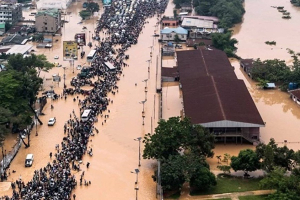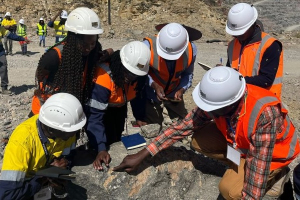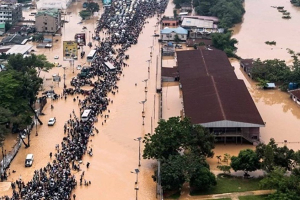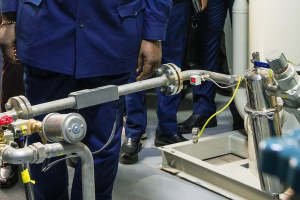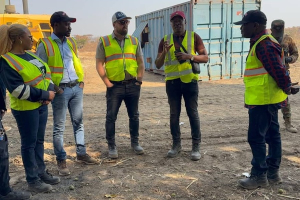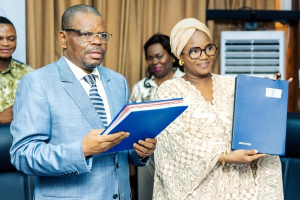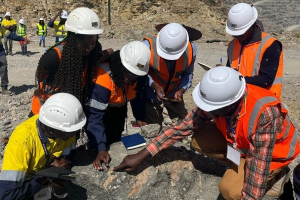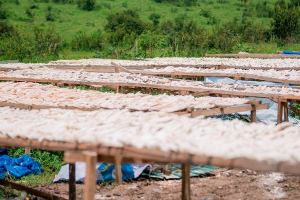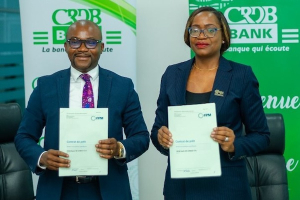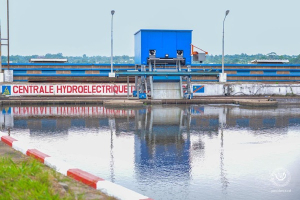Equipe Publication
DRC to Integrate Climate Criteria into Public Investment Governance under IMF Deal
Highlights:
• Reform will align public investments with climate resilience and emissions goals.
• Revised PPP law and climate assessment methodology expected by September 2025.
• Climate-aligned projects to be costed and integrated into the national budget framework.
The Democratic Republic of Congo (DRC) has pledged to embed climate considerations into public investment decisions, under its agreement with the IMF's Resilience and Sustainability Facility (RSF). A key step involves updating the law on public-private partnerships (PPPs) to include climate analysis criteria, particularly project resilience and greenhouse gas impact.
Launched in December 2024 with an IMF technical mission, the reform led to a formal roadmap and the establishment of an inter-institutional expert commission by May 2025. The African Legal Support Facility (ALSF) is set to assist this process, with technical input expected no later than September 2025.
Simultaneously, the DRC is working on a climate impact assessment method for all public investment projects. This methodology will guide pre-budget climate impact reviews and was the subject of a technical mission last May. A final roadmap is due by September this year.
As part of this broader effort, the government will publish a list of priority climate-aligned projects from its 2021 Nationally Determined Contribution (NDC). These projects will be integrated into the Public Investment Program (PIP) and assigned specific funding.
This article was initially published in French by Boaz Kabeya (Intern)
Edited in English by Ola Schad Akinocho
DRC Taps U.S.’ Kobold and Japan’s Solafune to Boost Geological Data Access and Mining Exploration
Highlights:
• DRC signs strategic deals with KoBold Metals and Solafune to modernize geological data systems
• KoBold to digitize archives and launch exploration campaign over 1,600 km² by the end of July
• Solafune to support AI-based mapping and expert training under new MoU
The Democratic Republic of Congo has signed two preliminary agreements with U.S.-based KoBold Metals and Japan's Solafune Inc. to modernize access to geological data and bolster mineral exploration using artificial intelligence and satellite technology.
KoBold, backed by Bill Gates and Jeff Bezos, will digitize Congo’s geological archives held at the Royal Museum of Central Africa by July 31, 2025. The company also plans to launch large-scale mineral exploration, submitting permit applications covering 1,600 km² by the same date. Under the agreement, all data generated will be made publicly accessible through the National Geological Service of Congo (SGN-C), which will also act as the official platform for data validation and archiving.
Solafune, meanwhile, signed a memorandum of understanding to provide AI-driven support for geological mapping and train Congolese experts. The goal is to increase transparency and improve governance of mineral resources through better subsurface knowledge.
Congolese authorities describe the KoBold deal as a "strategic partnership" aimed at attracting U.S. investment. In 2024, the DRC led African mining exploration with $130.7 million in investment—10% of the continent’s total—according to S&P Global Market Intelligence.
This article was initially published in French by Ronsard Luabeya, intern
Edited in English by Ola Schad Akinocho
La RDC prépare une réforme des PPP pour y intégrer les enjeux climatiques
Dans le cadre de l'accord conclu avec le Fonds monétaire international (FMI) au titre de la Facilité pour la résilience et la durabilité (FRD), la République démocratique du Congo (RDC) s’est engagée à intégrer des critères climatiques dans la gouvernance de ses investissements publics. Selon le rapport publié en juillet 2025, cette réforme inclura notamment une mise à jour de la loi sur les partenariats public-privé (PPP), afin d’y insérer des références explicites aux analyses climatiques, en particulier la résilience des projets et leur impact sur les émissions de gaz à effet de serre.
La réforme a été amorcée dès décembre 2024, avec la tenue d'une mission d’assistance technique du FMI. Celle-ci a permis l’adoption d’une feuille de route, incluant la mise en place d’une commission interinstitutionnelle d’experts chargée de préparer un projet de loi révisé. La commission a été officiellement constituée fin mai 2025 et bénéficiera de l’appui technique de l’African Legal Support Facility (ALSF), attendu au plus tard en septembre.
Parallèlement, le gouvernement prévoit de formaliser une méthodologie d’évaluation climatique pour les projets d’investissement public, qu’ils soient budgétaires ou extrabudgétaires. Cette méthode devra permettre d’estimer en amont les impacts climatiques et d’en publier les résultats avant toute allocation budgétaire. Une mission technique s’est tenue en mai 2025, et une feuille de route détaillée devrait être achevée avant septembre.
Dans le prolongement de cet engagement, la RDC prévoit également de publier une liste de projets prioritaires alignés sur sa Contribution déterminée au niveau national (CDN) de 2021, qui sera intégrée au Programme d’investissements publics (PIP). Les coûts de ces projets seront chiffrés, avec des ressources budgétaires spécifiques dédiées à leur mise en œuvre.
Boaz Kabeya, stagiaire
Lire aussi :
Réduction des émissions de carbone : la RDC reçoit une récompense de 19, 47 millions $
RDC-FMI : feu vert pour le nouveau programme de près de 3 milliards de dollars
Changement climatique : un rapport pointe l’impact des mines au Katanga
Oxygène médical : la RDC inaugure sa première unité de production locale
Le ministre de l’Industrie et du Développement des PME-PMI, Louis Watum Kabamba, a inauguré, le 19 juillet 2025, l’usine Oxygaz RDC, filiale du Groupe Mike Food & Services (MFS), dans la commune de Limete, à Kinshasa. Il s’agit de la toute première unité industrielle spécialisée dans la production de gaz médicaux, pharmaceutiques, industriels et aéronautiques en République démocratique du Congo (RDC).
Cette usine répond à un besoin criant dans le pays : l’accès limité des hôpitaux congolais à l’oxygène médical. Selon Mike Lundadila Koketua, président du Groupe MFS, près de 75 % des structures hospitalières du pays n’ont jamais été approvisionnées depuis leur création, et seulement 15 % bénéficient aujourd’hui d’un approvisionnement en oxygène de manière continue.
Le projet, d’un coût total de près de 3,6 millions de dollars, a été financé par un investissement privé congolais de 2 millions de dollars, complété par un appui de 1,6 million dollars du Fonds de promotion de l’industrie (FPI), a précisé le ministre Louis Watum lors de la cérémonie.
Créé en 2018, le Groupe MFS est une entreprise congolaise active dans plusieurs secteurs : agroalimentaire, immobilier, logistique, commerce général, industrie et mines. À travers sa filiale Oxygaz RDC, il s’impose désormais comme le premier producteur local de bouteilles d’oxygène et d’azote.
L’usine génère actuellement 50 emplois directs et 100 emplois indirects, avec une extension prévue dans d’autres provinces du pays.
Ronsard Luabeya, stagiaire
East African Power lance deux centrales solaires de 266 MWc dans des zones minières
Le développeur canadien East African Power (EAP) a officiellement lancé, le 20 juillet 2025, un projet de construction de deux centrales solaires d’une capacité installée de 133 mégawatts crête (MWc) chacune, dans les provinces du Haut-Katanga et du Lualaba, au sud-est de la République démocratique du Congo (RDC).
Les deux infrastructures seront implantées dans les territoires de Kambove (Haut-Katanga) et Mutshatsha (Lualaba), des zones à forte activité minière. D’une durée de réalisation estimée à deux ans, les travaux visent à renforcer l’approvisionnement en électricité dans cette région industrielle, notamment pour les villes de Kolwezi et Likasi, qui devraient figurer parmi les principales bénéficiaires.
Les centrales sont conçues pour générer 494 GWh d’électricité propre par an, contribuant ainsi à une réduction estimée de 5 400 tonnes de CO₂. L’énergie produite sera vendue à la Société nationale d’électricité (SNEL), dans le cadre d’un contrat d’achat d’électricité signé pour une durée de 20 ans.
Le projet prévoit la création de plus de 800 emplois directs et indirects pendant les phases de construction et d’exploitation. Il comprend également une dimension sociale, avec la construction d’infrastructures communautaires essentielles : à Kambove, il est prévu d’ériger des écoles, des centres de santé et des espaces commerciaux, tandis qu’à Mutshatsha, une école et un hôpital sont déjà confirmés.
Soutien des Etats-Unis
Ce projet est financé conjointement par la Banque pour le commerce et le développement (TDB) et l’Agence des États-Unis pour le développement international (USAID), à travers les programmes East Africa Power Program et Sustainable Capital Africa Facility. Ces dispositifs visent à promouvoir les investissements durables dans le secteur énergétique en Afrique. Dans ce cadre, l’USAID prévoit un engagement financier de 15,5 millions de dollars sur trois ans pour soutenir le East Africa Power Program.
Le montant total de l’investissement n’a pas été précisé. Toutefois, la clôture financière du projet est intervenue en 2024. Pendant la phase préparatoire, East African Power a bénéficié de l’appui technique de la TDB pour actualiser les études et la documentation du projet, conformément aux normes environnementales et sociales de la Banque mondiale.
Le projet est mené en partenariat avec le Groupe Ihusi. Cette société congolaise fondée en 2009 est active principalement dans l’est du pays. le Groupe est notamment connu à travers sa filiale Ihusi Gaz Sarl, spécialisée dans le transport, le stockage et la distribution de gaz GPL. Les détails sur la nature exacte de cette collaboration n’ont pas encore été rendus publics.
EAP ambitionne de déployer 1 GW d’énergie renouvelable d’ici 2030. Fondée en 2012, la société revendique déjà plus d’une dizaine de projets opérationnels et une cinquantaine en développement à travers l’Afrique.
Ronsard Luabeya, stagiaire
Lire aussi :
Électricité : Kamoa Copper projette d’installer 120 MW de solaire sur son site minier
Électricité : Moyi Power lance la mobilisation de 180 millions $ pour un projet en RDC
Électricité : la production de la RDC en hausse de 303 GWh en 2024, mais des défis persistent
Un plan conjoint PNUD-FPI pour financer des artisans et petits agriculteurs
Le Programme des Nations unies pour le développement (PNUD) et le Fonds de promotion de l’industrie (FPI) ont posé, le 11 juillet 2025 à Kinshasa, les bases d’un partenariat de deux ans visant à contribuer à une croissance économique inclusive et durable en République démocratique du Congo (RDC). Ce protocole d’accord établit un cadre de coopération autour de trois axes prioritaires : l’inclusion financière, le renforcement des capacités techniques, et l’appui à l’entrepreneuriat local, notamment dans le secteur agricole.
L’initiative prévoit un soutien direct aux petits cultivateurs et artisans, principalement situés dans les zones rurales et périurbaines. L’accord met l’accent sur l’amélioration de l’accès au financement pour les groupes vulnérables — femmes, jeunes et personnes en situation de précarité — dont les projets s’inscrivent dans la création de chaînes de valeur agricoles.
Par ailleurs, le partenariat inclut le renforcement des capacités des prestataires de services financiers (PSF), appelés à mieux accompagner les activités économiques locales. Il prévoit aussi leur implantation dans des zones encore non couvertes par les institutions de microfinance ou les coopératives d’épargne et de crédit. Un appui est également envisagé pour renforcer la gestion interne des incubateurs et améliorer les compétences managériales et organisationnelles des micros, petites et moyennes entreprises.
Les sommes qui seront engagées dans le cadre de ce partenariat n’ont pas été précisées. L’accord ne donne pas non plus d’informations sur les critères de sélection des bénéficiaires ni sur la répartition géographique des interventions prévues.
Ce partenariat s’inscrit dans la continuité des engagements antérieurs des deux institutions. En 2023, le Fonds de promotion de l’industrie a financé plus de 80 projets à travers le pays, pour un montant global de 115,6 millions de dollars, dont plusieurs ont concerné l’agro-industrie. De son côté, le PNUD avait lancé, depuis 2019, le programme ACTIF (Action, Changement et Transformation par l’Inclusion Financière), centré sur l’accès aux services financiers et le soutien aux chaînes de valeur agricoles. Les orientations de ce nouveau partenariat reprennent ainsi des axes déjà expérimentés par les deux institutions.
Boaz Kabeya, stagiaire
Prospection minière : la RDC prend un virage technologique avec KoBold et Solafune
La République démocratique du Congo (RDC) a conclu, en l’espace de 24 heures, deux accords préliminaires avec l’Américain KoBold Metals et le Japonais Solafune Inc., en vue de moderniser la recherche et l’accès aux données géologiques. Ces deux entreprises, déjà actives notamment en Zambie, ont la particularité d’utiliser l’intelligence artificielle et les données satellitaires pour optimiser l’exploration minière.
Selon le premier accord, signé le 17 juillet 2025, KoBold Metals déploiera une équipe chargée de numériser les archives géologiques conservées au musée royal d’Afrique centrale, d’ici le 31 juillet 2025. En outre, les deux parties se sont engagées à coopérer pour garantir un accès public et gratuit aux données géoscientifiques via le Service géologique national du Congo (SGN-C). « Cela signifie que le SGN-C servira de plateforme nationale d’archivage, de validation et de diffusion des données géologiques générées par KoBold dans ses campagnes d’exploration », précise un expert.
Soutenue par des investisseurs tels que Bill Gates et Jeff Bezos, la société américaine prévoit également de lancer un programme d’exploration minière à grande échelle en RDC pour identifier des gisements de minéraux critiques. À cet effet, KoBold déposera d’ici le 31 juillet 2025 des demandes de permis couvrant plus de 1 600 km².
De son côté, la société Solafune a signé un protocole d’accord avec le SGN-C. Celui-ci prévoit un accompagnement technique dans l’utilisation de l’IA et des images satellitaires pour améliorer la connaissance du sous-sol congolais, en vue d’une gouvernance plus transparente et efficace des ressources minérales. Le texte prévoit notamment le renforcement des capacités techniques des experts congolais.
La bonne connaissance du sous-sol est un levier stratégique pour attirer les investissements miniers. Kinshasa présente d’ailleurs l’accord avec KoBold comme un « partenariat stratégique visant à ouvrir la voie aux investissements américains dans le secteur ».
En 2024, les compagnies minières ont investi 130,7 millions de dollars dans l’exploration en RDC, selon un rapport de S&P Global Market Intelligence publié le 21 février 2025. Ce montant représente 10 % des 1,3 milliard de dollars investis à l’échelle du continent africain, faisant de la RDC le leader du secteur en Afrique.
Ronsard Luabeya, stagiaire
Lire aussi :
Permis miniers : la RDC gèle les demandes pour assainir son registre
Exploration minière : la RDC en tête en Afrique avec 130,7 millions $ captés en 2024
Minerais critiques : les réserves de la RDC estimées à 24 000 milliards $
Manioc : la RDC compte sur la FAO pour accélérer l’industrialisation de la filière
Selon le ministre de l’Agriculture, Grégoire Mutshail Mutomb, cité par l’Agence congolaise de presse (ACP), l'Organisation des Nations unies pour l'alimentation et l'agriculture (FAO), accompagnera la République démocratique du Congo (RDC), dans l’industrialisation de la culture du manioc. Objectif : créer des emplois, de lutter contre la faim et la pauvreté.
Cette annonce fait suite à la première édition du forum intercontinental « High-Level Inter-regional Knowledge Exchange on One Country One Priority Product (OCOP) Models », coorganisé par la FAO et le Vietnam, du 15 au 17 juillet à Hanoï. L’événement a réuni les ministres de l’Agriculture de 17 pays africains et asiatiques, dont la RDC.
Selon le ministre Mutshail, l’appui de l’organisation onusienne vise notamment le développement de la transformation du manioc en farine panifiable — une farine destinée à être mélangée à celle de blé dans la fabrication du pain. Les contours précis de cette coopération restent à définir. « Nous aurons encore des rencontres dans les mois à venir. Si tout se passe bien, la prochaine réunion pourrait se tenir ici même en RDC », a précisé le ministre.
Cette initiative devrait compléter les efforts déjà engagés pour industrialiser la filière manioc et accroître la valeur ajoutée locale.
En avril 2023, le gouvernement avait adopté un projet visant à intégrer la farine de manioc à hauteur de 20 % dans la farine de blé pour la panification, et à 100 % dans les pâtisseries (gâteaux, gaufres) et les pizzas. L’objectif affiché était de réduire la facture annuelle des importations de blé, estimée à 87 millions de dollars, dans un contexte de forte dépendance aux exportations de Russie et d’Ukraine, et de tensions sur les prix.
Malgré ces ambitions, la filière manioc est confrontée à de nombreux obstacles. Dans un rapport publié en septembre 2023, la Banque mondiale soulignait que l’environnement des affaires congolais reste peu propice au développement de l’agro-industrie. Les micros, petites et moyennes entreprises (MPME) actives dans la chaîne de valeur du manioc doivent composer avec une lourdeur administrative, une fiscalité élevée, des difficultés d’accès à la terre et au crédit, ainsi qu’un manque criant d’infrastructures de base comme l’électricité et les routes.
Dans ce contexte, le ministre Mutshail insiste sur l’importance d’un engagement budgétaire clair de la part des autorités congolaises. Pour lui, ce partenariat avec la FAO doit s’accompagner d’une volonté politique forte pour intégrer la filière manioc dans la planification économique nationale.
Stéphanas Assocle
Lire aussi :
Riz, maïs et manioc : un prêt de 260,4 millions $ de la BAD pour accroître la production
Après le cacao, Mole Group initie un projet dans le manioc, le maïs et le sucre en RDC
Comment la transformation du manioc peut dynamiser l'économie agricole en RDC
FPM Grants Senior Loan to CRDB Bank Congo to Boost SME and Youth Lending
The Financial Inclusion Fund (FPM SA) has signed a loan agreement with CRDB Bank Congo SA, the Congolese branch of Tanzania’s CRDB Bank. The official ceremony took place in Lubumbashi, attended by Patrick Nkongo, FPM’s CEO, and Jessica Nyachiro, Managing Director of CRDB Bank Congo.
While the amount of the loan was not disclosed, FPM confirmed that it is a senior debt facility. This type of loan gives repayment priority in the event of borrower default, bankruptcy, or liquidation, and is usually backed by the borrower’s assets, minimizing credit risk for the lender.
With this funding, CRDB Bank Congo plans to grow its loan portfolio, focusing on key sectors such as agriculture, support for women entrepreneurs, and youth-led businesses. Leaders from both institutions said the deal aims to promote the growth of small and medium enterprises and foster inclusive economic development in the Democratic Republic of Congo.
The agreement is part of FPM’s broader strategy to enhance the quality of its financing portfolio by working with institutions committed to high-impact sectors. According to its 2024 Pillar III report, FPM has deepened partnerships with local banks and shifted its focus toward refinancing tools, portfolio guarantees, and credit lines backed by development partners such as the World Bank and German cooperation agency KfW.
Earlier this year, FPM signed a similar deal with Rawbank in April and recently secured a new funding line from Dutch development bank FMO.
The loan comes as CRDB Bank Congo works to strengthen its operations in the DRC. Despite posting a $2.5 million loss in 2024 due to expansion costs, the bank has seen strong improvements: deposits have increased tenfold, total assets now exceed $70 million, and net interest margins have improved, driven partly by investments in Congolese government bonds.
CRDB has been operating in the DRC since May 2023 and continues to invest in the country’s growth potential. The new partnership with FPM will boost its ability to fund high-impact sectors and expand access to finance across underserved groups.
DRC Approves $173mln Plan to Boost Electricity Access in Kisangani
On July 18, the Council of Ministers approved a $173.3 million electrification project for the city of Kisangani. The plan aims to improve access to electricity by upgrading key infrastructure and expanding the local grid.
According to Teddy Lwamba, Minister of Hydraulic Resources and Electricity, the project includes the rehabilitation of two turbines—G2 and G3—at the Tshopo 1 hydroelectric plant, each with a capacity of 6.5 MW. It also calls for the construction of a 5 MW solar power plant and the modernization and extension of the distribution network, including the installation of prepaid meters.
The financing strategy for the project has not yet been finalized. The Council’s report mentions several possible options, combining domestic resources with support from international donors. A consultation meeting is planned to coordinate approaches and confirm operational details.
In April 2025, a technical meeting in Kinshasa brought together government officials and experts, including representatives of Congo Énergie, the company overseeing the project, working in partnership with the national electricity utility SNEL. At that meeting, it was noted that a full overhaul of the Tshopo 1 plant—including the replacement of all three turbines—could raise the facility’s capacity to 20 MW.
An earlier field mission to Kisangani in July 2024, which included lawmakers and SNEL representatives, confirmed that preliminary work had already begun at the Tshopo 1 plant and in parts of the Lubunga commune. This initial phase was partly funded by the Special Fund for the Repair and Compensation of Victims of Ugandan Armed Activities (Frivao).





